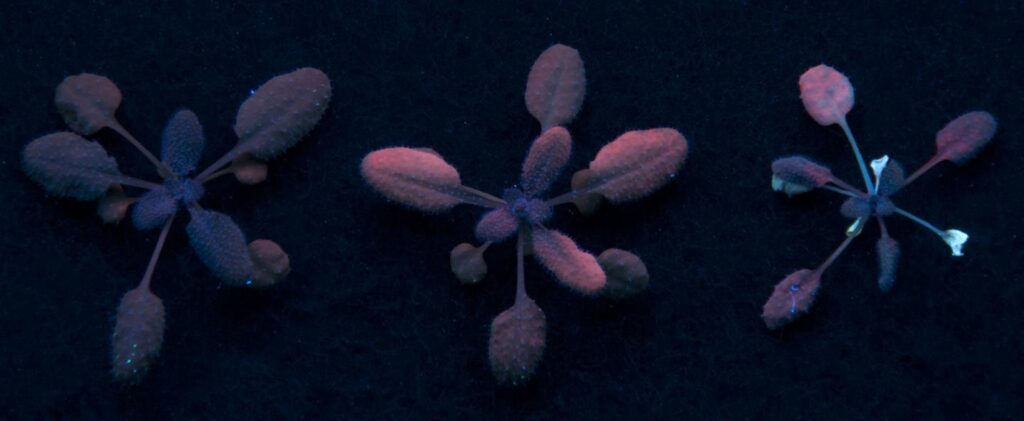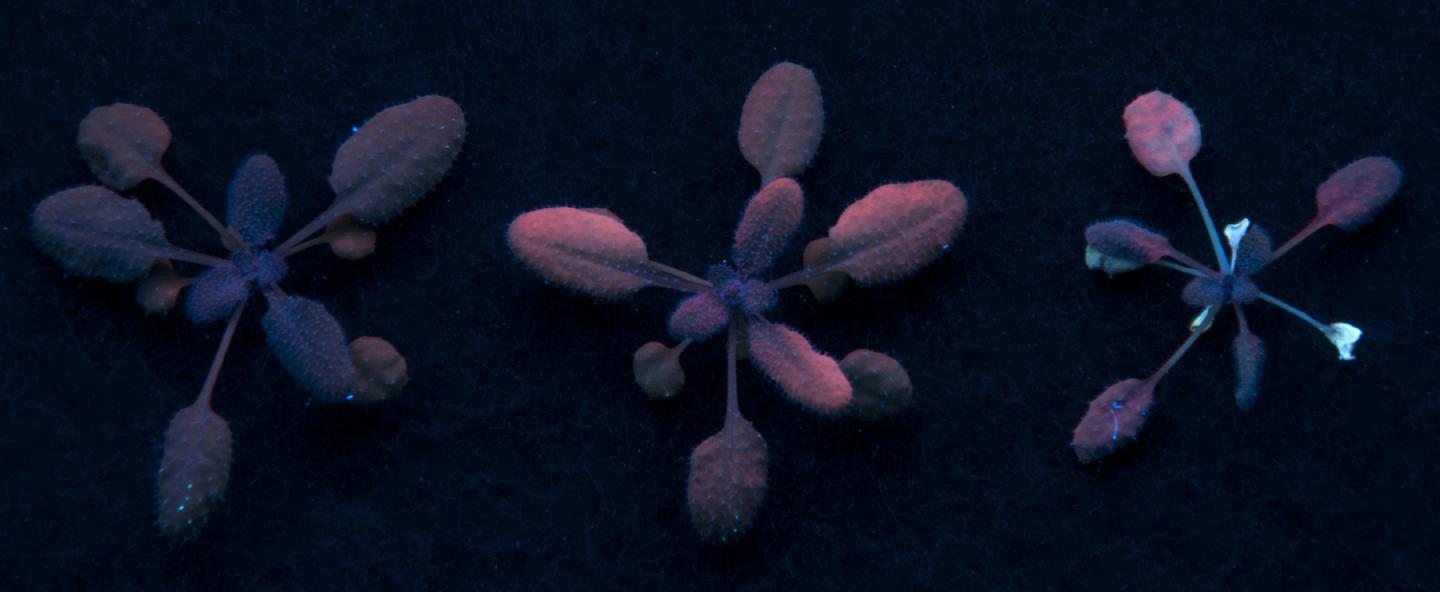
CREDIT: Y. KOO/RICE UNIVERSITY
In one of the most comprehensive laboratory studies of its kind, Rice University scientists traced the uptake and accumulation of quantum dot nanoparticles from water to plant roots, plant leaves and leaf-eating caterpillars.
The study, one of the first to examine how nanoparticles move through human-relevant food chains, found that nanoparticle accumulation in both plants and animals varied significantly depending upon the type of surface coating applied to the particles. The research is available online in the American Chemical Society’s journal Environmental Science & Technology.
“With industrial use of nanoparticles on the rise, there are increasing questions about how they move through the environment and whether they may accumulate in high levels in plants and animals that people eat,” said study co-author Janet Braam, professor and chair of the Department of BioSciences at Rice.
Braam and colleagues studied the uptake of fluorescent quantum dots by Arabidopsis thaliana, an oft-studied plant species that is a relative of mustard, broccoli and kale. In particular, the team looked at how various surface coatings affected how quantum dots moved from roots to leaves as well as how the particles accumulated in leaves. The team also studied how quantum dots behaved when caterpillars called cabbage loopers (Trichoplusia ni) fed upon plant leaves containing quantum dots.
“The impact of nanoparticle uptake on plants themselves and on the herbivores that feed upon them is an open question,” said study first author Yeonjong Koo, a postdoctoral research associate in Braam’s lab. “Very little work has been done in this area, especially in terrestrial plants, which are the cornerstone of human food webs.”
Some toxins, like mercury and DDT, tend to accumulate in higher concentrations as they move up the food chain from plants to animals. It is unknown whether nanoparticles may also be subject to this process, known as biomagnification.
Read more: Scientists trace nanoparticles from plants to caterpillars
The Latest on: Nanoparticle accumulation
[google_news title=”” keyword=”Nanoparticle accumulation” num_posts=”10″ blurb_length=”0″ show_thumb=”left”]
via Google News
The Latest on: Nanoparticle accumulation
- Poseida Highlights Strong Progress on Its Genetic Medicine Programs at the American Society for Gene and Cell Therapy 27th Annual Meetingon May 9, 2024 at 7:18 am
NDAQ:PSTX) Poseida Highlights Strong Progress on Its Genetic Medicine Programs at the American Society for Gene and Cell Therapy 27th Annual Meeting ...
- Enabling rapid screening of poly(2-oxazoline)-based nanomedicine through divergent synthesison May 8, 2024 at 8:20 am
Reactive end-groups on non-immunogenic biocompatible polymers, such as PEG, are frequently used in the synthesis of nanomedicine, whereby the biocompatible polymer improves the stability and blood ...
- CRISPR Therapeutics Highlights ASGCT Oral Presentation and Announces New Programs Utilizing In Vivo Gene Editing Approachon May 8, 2024 at 12:00 am
ASGCT presentation demonstrates lipid nanoparticle (LNP) mediated delivery to the eye ... CTX450 is specifically designed to inhibit production of ALAS1 in the liver, preventing accumulation of ...
- Enabling rapid screening of poly(2-oxazoline)-based nanomedicine through divergent synthesis; towards alternative mRNA-vaccineson May 5, 2024 at 5:00 pm
Reactive end-groups on non-immunogenic biocompatible polymers, such as PEG, are frequently used in the synthesis of nanomedicine, whereby the biocompatible polymer improves the stability, blood ...
- Nanoparticle News and Researchon May 1, 2024 at 5:00 pm
Study explores nanoparticle-enhanced curcumin formulations, promising to significantly boost its health benefits including anticancer, antioxidant, and anti-inflammatory effects by improving ...
- Nanoparticles in Targeted Cancer Therapyon May 1, 2024 at 5:00 pm
Tumor retention and accumulation of mesoporous silica nanoparticles. Fluorescently labeled FA-PEI-MSNs and PEI-MSNs were injected either peritumorally or intravenously, and the biodistribution of ...
- Scientists reveal nanoparticle that can treat Alzheimer’s disease in miceon May 1, 2024 at 11:45 am
Researchers say a promising new therapy targets protein clusters that likely cause neuron death and brain atrophy in Alzheimer’s disease.
- Gold Nanoparticle Sensors for Detecting Chronic Kidney Disease and Disease Progressionon April 16, 2024 at 5:01 pm
We assume that this is related to the continual death of kidneys nephrons, as up to 60% of the nephrons die before an accumulation ... types of spherical gold nanoparticles. The results showed ...
- Ultrasound-launched targeted nanoparticle enhances antibacterial sonodynamic therapy for effective eradication of pseudomonas aeruginosa biofilmon April 14, 2024 at 5:00 pm
A novel ultrasound-launched targeted nanoparticle was developed to universally destroy biofilm, target bacteria, deliver antibiotics, and efficiently kill bacteria via ultrasonic cavitation and ...
- New micromaterial releases nanoparticles that selectively destroy cancer cellson April 5, 2024 at 10:35 am
and how the released protein nanoparticles accumulated in tumor tissues. "It is important to highlight that this accumulation is more efficient than when the protein is administered in blood.
via Bing News











